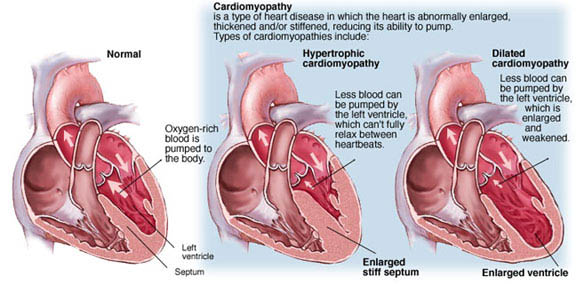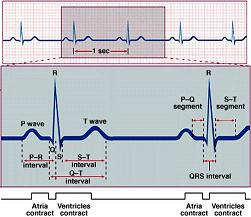Dilated Cardiomyopathy
(from sources on our Heart Links) page)
INTRODUCTION

Cardiomyopathy is a disease of the heart muscle. The heart loses
its ability to pump blood and, in some instances, heart rhythm is disturbed,
leading to irregular heartbeats, or arrhythmias. Usually, the exact cause of the
muscle damage is never found.
Cardiomyopathy differs from many other
heart disorders in a couple of ways. First, it is fairly uncommon, affecting
about 50,000 Americans. However, the condition is a leading reason for heart
transplantation.
Second, unlike many other forms of heart disease that
affect middle-age and older persons, cardiomyopathy can, and often does, occur
in the young. The condition tends to be progressive and sometimes worsens fairly
quickly.
DILATED (CONGESTIVE) CARDIOMYOPATHY
By far the most common type of heart muscle
disease, dilated cardiomyopathy occurs when diseased muscle fibers have
stretched, leading to enlargement, or dilation, of a chamber of the heart. This
weakens the heart's pumping ability. The heart tries to adjust by further
enlarging and stretching--a process known as "compensation."
Dilated cardiomyopathy occurs most often in middle-age people and more often in men than
women. However, the disease has been diagnosed in people of all ages, including
children.
 In most cases, the disease is idiopathic--a specific cause for the damage is never
identified.
In most cases, the disease is idiopathic--a specific cause for the damage is never
identified.
But some factors have been linked to the disease's
occurrence. For instance, alcohol has a direct suppressant effect on the heart,
and chronic, excessive consumption of alcohol may cause dilated cardiomyopathy.
Also, dilated cardiomyopathy occasionally occurs as a complication of pregnancy
and childbirth. Other factors are: a variety of infections, mostly viral, which
lead to an inflammation of the heart muscle (myocarditis); toxins (such as
cobalt); and, rarely, heredity.
Some drugs, used to treat a different
medical condition, also can damage the heart and produce the condition. Such
drugs include doxorubicin and daunorubicin, both used to treat
cancer.
Whatever the cause, the clinical and pathological signs of
dilated cardiomyopathy are usually the
same.
Symptoms--
Dilated cardiomyopathy can be present
for several years without causing significant symptoms. With time, however, the
enlarged heart gradually weakens.
This condition is commonly called
"heart failure," and it is the hallmark of dilated cardiomyopathy. Typical signs
and symptoms of heart failure include: fatigue; weakness; shortness of breath,
sometimes severe and accompanied by a cough, particularly with exertion or when
lying down; and swelling of the legs and feet, resulting from fluid accumulation
that may also affect the lungs (congestion) and other parts of the body and that
produces abnormal weight gain. (The cough and congestion mimic, and so can be
misdiagnosed as, pneumonia or acute bronchitis.)
Because of the congestion, some physicians use the older term "congestive cardiomyopathy" to
refer to dilated cardiomyopathy. In advanced stages of the disease, the
congestion may cause pain in the chest or abdomen.
In advanced stages, some patients develop irregular heartbeats, which can be serious and even
life-threatening.
Diagnosis--
Once symptoms appear, the condition is often tentatively diagnosed based on a physical examination and a
patient's medical history. As part of the examination, a stethoscope is used to
detect abnormal heart sounds, which are typical of the condition.
 A final diagnosis may also require a chest x-ray to show whether the
heart is enlarged, an electrocardiogram to reveal any abnormal electrical
activity of the heart, and an echocardiogram, which uses sound waves to produce
pictures of the heart.
A final diagnosis may also require a chest x-ray to show whether the
heart is enlarged, an electrocardiogram to reveal any abnormal electrical
activity of the heart, and an echocardiogram, which uses sound waves to produce
pictures of the heart.
Other, more specific tests may also be needed.
These include:
*A radionuclide ventriculogram. This involves injecting
low-level radioactive material (usually equal to that in a set of chest x rays)
into a vein, through which it flows to the heart. There, the material is picked
up by a computer, which generates pictures showing how well the heart is
functioning.
*A cardiac catheterization. In this procedure, a thin
plastic tube is inserted into and through a blood vessel until it reaches the
heart. A dye is injected, and x rays are taken to assess the heart's structure
and function.
Treatment--
Dilated cardiomyopathy is
hard to diagnose early. So, it is rarely treated in its beginning stage.
The goal of treatment is to relieve any complicating factor, if known,
control the symptoms, and stop the progression. However, no cure now
exists.
Therapy begins with the elimination of obvious risk factors, such
as alcohol consumption. Weight loss and dietary changes, especially salt
restriction, may also be advised.
 Drugs used to treat the condition include:
Drugs used to treat the condition include:
*Diuretics, which reduce excess fluid in the
body;
*Digitalis, which helps to improve pumping action and regulate the
heartbeat;
*Vasodilators, such as angiotensin-converting enzyme (ACE)
inhibitors, which relax blood vessels, helping to lower to pump blood through
the body; and
*Calcium blockers or beta blockers, which may be used in
some patients to help regulate the heartbeat.
Also, patients with
irregular heartbeats may be put on any of various drugs to control the
rhythm.
Sometimes, if the condition is advanced and the patient does not
sufficiently respond to other treatments, a heart transplantation may be
performed. The patient's heart is replaced with a donor heart. Most heart
transplant recipients are under age 60 and in good health other than their
diseased heart.
Course of the disease--
As the heart
enlarges, it steadily loses its ability to circulate blood. As a result, some
patients cannot perform even simple physical activities.
However, the
disease also can remain fairly stable for years, especially with treatment and
regular evaluation by a physician.
Unfortunately, by the time it is
diagnosed, the disease often has reached an advanced stage, and heart failure
has occurred. Consequently, about 50 percent of patients with dilated
cardiomyopathy live 5 years once heart failure is diagnosed; about 25 percent
live 10 years after such a diagnosis.
Typically, patients die from a
continued decline in heart muscle strength, but some die suddenly of irregular
heartbeats.
For patients with advanced disease, heart transplantation
greatly improves survival: 75 percent of patients live 5 years after a
transplantation. However, the scarcity of donor hearts limits its availability
to about 2,000 Americans a year. People who qualify for heart transplantation
often have to wait months, or even years, for a suitable donor heart. Some
patients with dilated cardiomyopathy die awaiting a transplant but, according to
recent studies, others improve enough from aggressive medical treatment to be
taken off the waiting list.
Also, some critically ill cardiomyopathy
patients with declining heart function use a small, implanted mechanical pump as
a bridge to transplantation. Called left ventricular assist devices (LVADs),
these pumps take over part or virtually all of the heart's blood pumping
activity. The devices provide only temporary assistance and are not now used as
substitutes for heart transplantation.
FUTURE DIRECTIONS
Future advances in the diagnosis and treatment of
cardiomyopathy depend on a better understanding of the disease process and why
heart muscle is damaged. A lot of research is under way to identify these
processes and whether they can be halted or even reversed. Much of the research
is conducted at or supported by the NHLBI.
 Promising clues came
from a team of NHLBI investigators that discovered some of the genes responsible
for hypertrophic cardiomyopathy. Their work represents an important first step
in understanding how the disease is transmitted and how it
progresses.
Promising clues came
from a team of NHLBI investigators that discovered some of the genes responsible
for hypertrophic cardiomyopathy. Their work represents an important first step
in understanding how the disease is transmitted and how it
progresses.
Researchers also are trying to determine the best use of
currently available treatments, especially drug therapies. Drugs useful for
other conditions may help treat cardiomyopathy. For example, drugs effective in
treating high blood pressure also help manage heart failure and irregular
heartbeats.
Additionally, much work has been--and continues to beódone on
identifying factors that increase or decrease a person's risk of death in
cardiomyopathy. Knowing which patients are at the greatest risk is very
important in determining the best approach to the evaluation and treatment of
their condition.
The development of improved treatments for
cardiomyopathy, however, awaits still more research and a better understanding
of the disease process.
GLOSSARY
ANGIOTENSIN-CONVERTING
ENZYME (ACE) INHIBITOR--A drug used to decrease pressure inside blood
vessels.
ARRHYTHMIA--An irregular heartbeat.
BETA BLOCKER--A drug used to slow the heart rate and reduce pressure inside blood vessels. It
also can regulate heart rhythm.
CALCIUM-CHANNEL BLOCKER--A drug used
to relax the blood vessel and heart muscle, causing pressure inside blood
vessels to drop, or to regulate heart rhythm.
CARDIAC ARREST--A sudden
stop of heart function. See also "sudden death."
CARDIAC
CATHETERIZATION--A procedure in which a thin, hollow tube is inserted into a
blood vessel and advanced into the heart, enabling a physician to study the
heart's activity.
CARDIOMYOPATHY--A disease of the heart muscle
(myocardium).
CONGESTION--Abnormal fluid accumulation in the body,
especially the lungs.
DIGITALIS--A drug used to increase the force of
the heart's contraction and to regulate specific irregularities of heart
rhythm.
DILATED CARDIOMYOPATHY--Heart muscle disease that leads to
enlargement of the heart's chambers, robbing the heart of its pumping
ability.
DIURETIC--A drug that helps eliminate excess body fluid;
usually used in the treatment of high blood pressure and heart
failure.
DYSPNEA--Shortness of breath.
ECHOCARDIOGRAPHY--A
test that bounces sound waves off the heart to produce pictures of its internal
structures.
EDEMA--Abnormal fluid accumulation in body
tissues.
ELECTROCARDIOGRAM (EKG, or ECG)--Measurement of electrical
activity during heartbeats.
HEART FAILURE--Loss of pumping ability by
the heart, often accompanied by fatigue, breathlessness, and excess fluid.
IDIOPATHIC--Results from an unknown cause.
LEFT VENTRICULAR ASSIST DEVICE (LVAD)--A mechanical device used to increase the heart's
pumping ability.
PULMONARY CONGESTION (OR EDEMA)--Fluid accumulation
in the lungs.
SEPTUM--In the heart, a muscle wall separating the
chambers.
SUDDEN DEATH--Cardiac arrest caused by an irregular
heartbeat. The term "death" is somewhat misleading, because some patients
survive.
VENTRICLES--The two lower chambers of the heart. The left
ventricle is the main pumping chamber in the heart.
VENTRICULAR FIBRILLATION--Rapid, irregular quivering of the heart's ventricles, with no
effective heartbeat.





 In most cases, the disease is idiopathic--a specific cause for the damage is never
identified.
In most cases, the disease is idiopathic--a specific cause for the damage is never
identified. A final diagnosis may also require a chest x-ray to show whether the
heart is enlarged, an electrocardiogram to reveal any abnormal electrical
activity of the heart, and an echocardiogram, which uses sound waves to produce
pictures of the heart.
A final diagnosis may also require a chest x-ray to show whether the
heart is enlarged, an electrocardiogram to reveal any abnormal electrical
activity of the heart, and an echocardiogram, which uses sound waves to produce
pictures of the heart. Drugs used to treat the condition include:
Drugs used to treat the condition include: Promising clues came
from a team of NHLBI investigators that discovered some of the genes responsible
for hypertrophic cardiomyopathy. Their work represents an important first step
in understanding how the disease is transmitted and how it
progresses.
Promising clues came
from a team of NHLBI investigators that discovered some of the genes responsible
for hypertrophic cardiomyopathy. Their work represents an important first step
in understanding how the disease is transmitted and how it
progresses.
